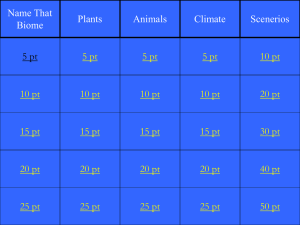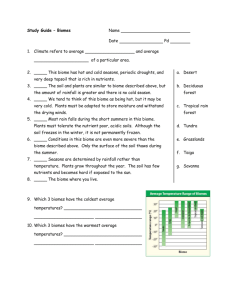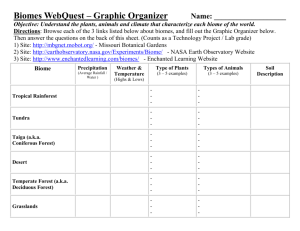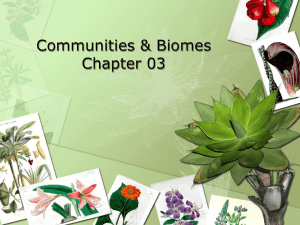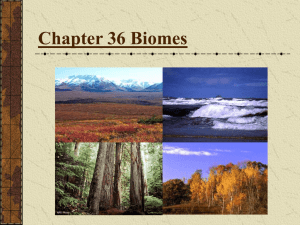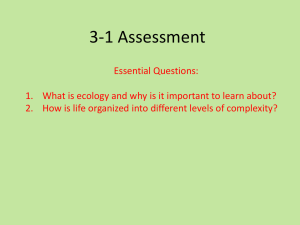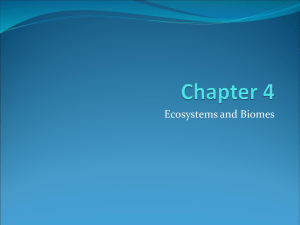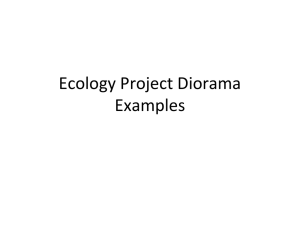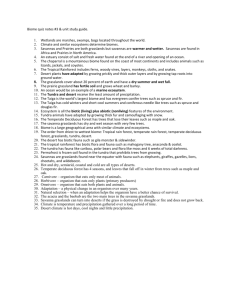Biomes
advertisement
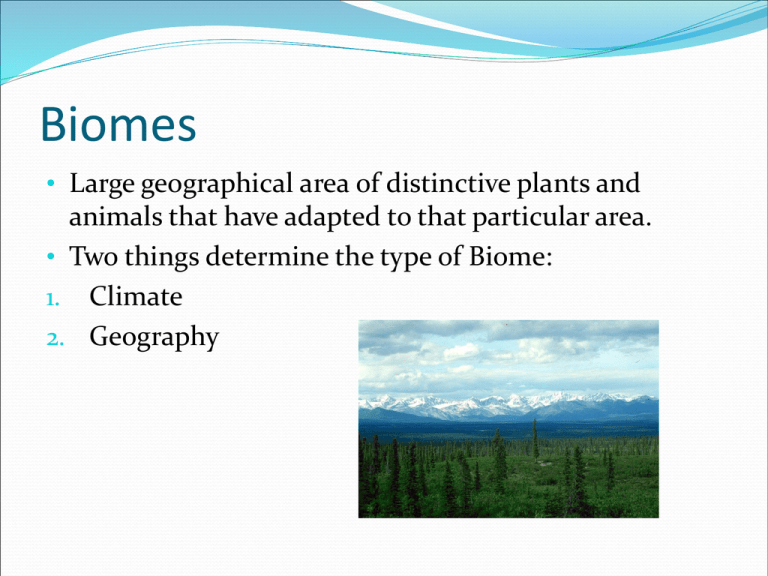
Biomes • Large geographical area of distinctive plants and animals that have adapted to that particular area. • Two things determine the type of Biome: 1. Climate 2. Geography Biomes All living things are closely related to their environment. Any change in one part of the environment (increase or decrease of plant or animal) causes a ripple effect that will change the environment. Biomes Types of Biomes: 1. 2. 3. 4. 5. 6. 7. 8. Tundra Evergreen Forest Deciduous Forest Grasslands Rainforest Desert Wetlands Coral Reef Tundra Tundra • Coldest places on Earth-Called the Land of Extremes • Polar Bears, Beluga Whales, Lichen • 2 Types: Arctic/North Pole 2. Alpine-High Mountains 1. Evergreen Forest • Found in parts of Europe, Brazil, and North America(Pacific Area) • Climate is sometimes warm, cool, and humid in the summer • Sometimes snow in the winter • Plants and Animals found in the Evergreens include: Pines Deciduous Frogs Deer Owls Deciduous Forest Deciduous Forest Sometimes called Temperate Forest Grow in middle latitudes around the globe Summer and winter are equal seasons Plants and Animals include: Maples, dogwoods, black bears, white-tailed-deer Grasslands • Savanna grasslands have tropical climate which have both wet and dry seasons. Dry seasons can cause droughts. • 3 Types of Grasslands: 1. Climatic (Tropic with rainfall of 20-50 inches a year with droughts 2. Derived- Cultivated by Farmers 3. Edaphic- Restrict the growth of trees Grasslands Climatic Grasslands Derived Grasslands Edaphic Rainforest Receive high annual rainfall due to location near the tropics Very humid Many birds and exotic animals live in rainforest Plants include moss and climbing plants Rainforest Used to cover 14% of Earth, but now only cover 6%!!!!!!!!!!!!!!!!!!!!!!!!!!!!! Desert Receive little to no precipitation Very hot reaching 140 degrees Other deserts are very hot during the day and very cold at night. Made up of sand, rock, pebbles Plateaus, Sand Dunes, cactus Camels, elephants, lions Desert Wetlands Every continent except Antarctica has wetlands. They release plant matter into rivers and streams that becomes food for fish and other wetland animals. Found in most deltas Wetlands 2 Types: Bogs (begins with small lakes or ponds with peat over the surface) 2. Fens (Support more plant life than bogs) 3. Marshes (fresh water or saltwater along edges of bodies of water) 4. Swamps (No grass, but shrubs and trees) 1. Wetlands Marigolds Crocodiles Carnivorous Plants Coral Reef and Oceans 5 Oceans Coral Reef is one of the most important marine biomes because it contains many habitats. Coral Reefs are responsible for the circulation of some of the ocean’s energy. Coral Reef and Oceans Plankton Coral Reef and Oceans Plankton are floating or drifting plants or animals which are microscopic. Jellyfish are intervertebrates and do not have brains. Green algae- single celled which use the sunlight to capture energy. Assignment Take out a sheet of paper and think about the biome that you are assigned. Write down key words and anything you know about that biome. Share your list with the group and list some additional keywords and important facts about that biome. Glance through the book that you are given to correct any misconceptions and obtain new information that you didn’t know about that biome. Be ready to present your findings about your biome…..remember you are the expert to that biome. Make sure to include the location, plants and animals that are found, climate, and other interesting facts.
